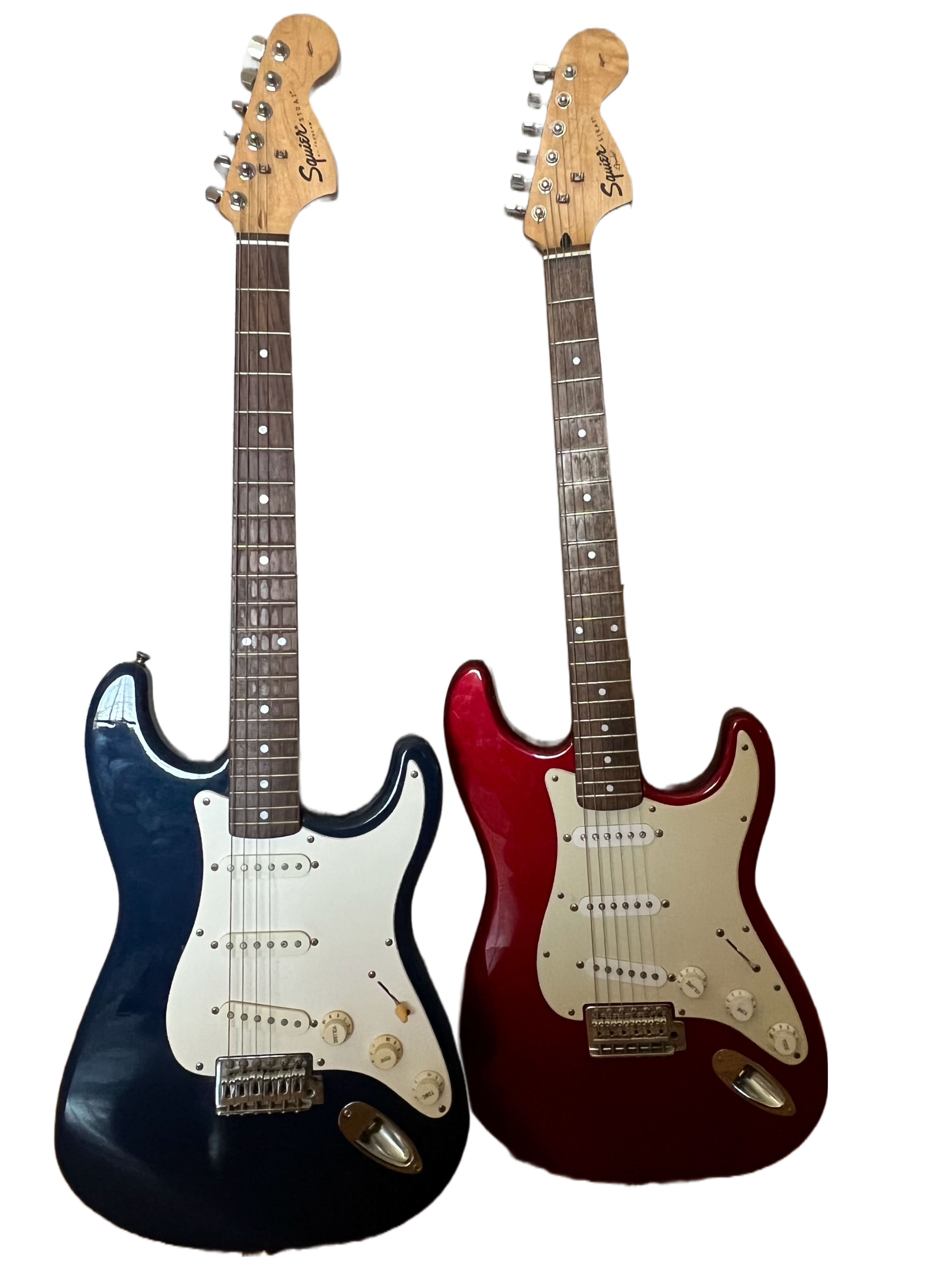 When I first learned about the Squier name and the brand’s affiliation with Fender I originally assumed that Fender had simply come up with a new brand name and called it a day. Little did I know the long history associated with the Squier name.
When I first learned about the Squier name and the brand’s affiliation with Fender I originally assumed that Fender had simply come up with a new brand name and called it a day. Little did I know the long history associated with the Squier name.
For those new to guitar, it is worth giving a quick overview of Fender and Squier guitars. Fender has been producing high end guitars since the 1940s. They are one of the premier guitar brands on the market. Some of their models are highly copied such as the Stratocaster and Telecaster, which are also produced under the Squier name.
While there is a strong appeal to owning a Fender not everyone can afford the price. The solution was a no brainer. In 1982 Fender began offering a budget friendly guitar called Squier. The Squier name offers the classic designs of Fender but with entry-level pricing.
History of the Squier Brand
When Leo Fender was producing electric guitars it goes without saying that he needed to add a set of electric guitar strings. Not specializing in guitar strings, the California guitar maker made a deal with Squier in the 1950s to provide them with strings for their electric guitars. The Squier brand at that time was known for their handmade guitar strings. In the 1960’s Squier was acquired by Fender and the company sold strings under this name until 1972.
After Mr. Fender sold his brand to CBS the company slowly started to decline. Sales were dwindling by the end of the 1970s and quality control issues hurt the perception of the Fender line-up. Just as crippling was the number of cheap Japanese copies that were cutting into sales.
To combat cheap overseas Japanese copies Fender decided to make a bold move. They decided to compete with themself by using the Squier name to sell budget friendly guitars while keeping Fender to sell their higher end guitars. The new Squier models would be offered as student edition guitars called the Bullet series, and some lower costing, yet identical looking guitars that looked like standard Fender models.
What Are Squier Electric Guitars?
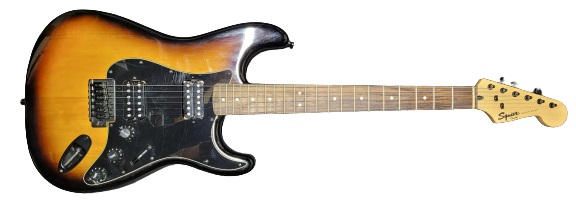
Squier is a guitar brand owned by the famous guitar company Fender. Squier is usually referred to as the “discount” or “beginner” alternative to some of the most popular electric guitar brands in the world.
However popular those claims might be it’s important to note that they aren’t knock-offs by any means.
See, Fender makes some of the most classic electric guitar models in history, and since Squier is their subsidiary, they are able to replicate these guitars more closely than any “knock-off” brand legally could.
For this reason, a Squier Telecaster is still a Telecaster, and a Squier Stratocaster is still a Stratocaster, just under a different brand. Conversely, countless other brands have made nearly identical guitars that they cannot call Telecasters.
How Long Have Squier Guitars Been Sold?
The Squier brand has been around since the late 19th century, originally starting as a small luthiery business with a primary focus on violins. However, guitarists from around the world now recognize this brand as the creator of affordable versions of the most iconic electric guitars.
During the peak season of electric guitars between the 1950s and 1970s, a few models stood out above all else, but the average beginner was unwilling or unable to pay for them.
Well, in 1982, Squier changed the game. After Fender had purchased the brand 17 years prior, Squier finally began making more affordable versions of these iconic electric guitars.
From there, a couple of generations of electric guitar players have had the option to make the sounds they want to make with their instruments without breaking the bank or going into debt.
Where Are They Built?
At first glance, their location may not seem important if you don’t know their history. However, arguably the biggest distinction between original models and their Squier versions is where they were built. While some Squier guitars are made at American shops owned by Fender, the majority are not. Most Squier guitars are built in Mexico or China, as well as some in India, Indonesia, Japan, and South Korea. We will go into more detail about this, but the location of the assembly plants themselves are one of the main factors that drive down the prices for Squier guitars.
Why Are Squier Electric Guitars So Cheap?
As we mentioned, Squiers are the cheaper alternative to some of the big brand names. So, how much do they cost? For context, the cost of a newer American Fender Telecaster is between $1,200 and $2,500. To buy one from the 1960s when they were most popular, you can expect to pay between $15,000 and $40,000.
On average, for Squier’s popular “Bullet Series” Telecasters and Stratocaster models, you should expect to pay as little as $150 to $400 for a new one. For some of their newer models, you may pay up to $600 for their higher-end series.
On the other hand, if you buy second-hand, you could get a decent Squier for as little as $80. Keep in mind, some of these lower-end guitars ;(especially used) may sacrifice quality for price in some cases.
Is the Quality Bad?
The first question to ask before buying a discount brand is whether or not the product is a piece of junk. Well, that may be the case in many other discount brands, but Squier guitars are a diamond in the ruff.
In most cases, Squiers will use cheaper pickups and a more efficient manufacturing process, but you will still generally receive almost identical sounds as you would with their derivative models. If you are a professional musician playing for large crowds, then this change may not be slight enough to justify.
However, if you are an intermediate guitarist playing at home or jamming with friends, then the difference in quality is too slight to care about, especially in the context of saving hundreds of dollars.
So, do they last or do Squiers need lots of repairs?
For some of the lower-end models, yes. Don’t expect to spend under $200 on any guitar and have it last for a lifetime. Although, you can take this on a case-by-case basis, and you shouldn’t expect any of them to bust within the first several years.
If you buy a higher quality Squier, they have a fairly good reputation. For a guitar in the $350 to $500 range, you’d be surprised how well some of them perform, often comparable to their original models. Many of them will last for decades!
Overall, they are owned by Fender, which is a brand with high-quality standards and a reputation to uphold. Fender wouldn’t let one of their subsidiaries produce junk guitars, so you should expect any Squier to last a decent amount of time.
Do Squier Guitars Stay In Tune?
A common complaint about cheaper Squier models, especially in the Bullet series, is that they won’t stay in tune. This causes plenty of frustration for guitarists of all skill levels, but especially for beginners.
When practicing, you want to hear yourself play the right notes and train your ear to hear how they are supposed to sound.
For that reason, we recommend either buying a guitar from the Affinity/Classic Vibe series or changing the tuners on your guitar. Otherwise, keep a tuner handy and try stretching the strings properly, as this should limit your frustration.
What Strings Come on Squier Guitars?
This depends on a number of factors, including whether you bought it first or secondhand, as well as the year and model. However, you will generally find the factory models come with .009 to .042-gauge strings made by Fender.
Prestige
According to research, 78% of Americans prefer products that were made in the United States. If you live in the US, that’s likely unsurprising to you. Well, not only is the location a factor, but also the name. Many guitarists may not have a clue where a guitar was built, and they may not even care, but the brand name does detract from the prestige of an instrument.
When a guitarist sees a Telecaster, they probably hear the tones of some of their favorite musicians and understand that a good instrument is an investment. For that reason, they’re often willing to pay premium prices for a well built guitar.
However, when they see a different name on the headstock (in this case, Squier), it detracts from the prestige, regardless of the quality. It also affects the long-term value of your instrument. Essentially, a Squier will likely depreciate in value, whereas their original models may increase.
For example, if you buy a Squier for $280, you play it for five years, and it gets a couple of scrapes on the body. Well, you may only find a buyer willing to pay $80 to $120, when an American Tele may increase in value.
Location
Yes, they are assembled primarily outside of the US, but that doesn’t affect the quality. In many cases, a lot of the components on Squier models are developed in the US and merely assembled in other countries for cheaper labor.
Of course, this drives down the price significantly. Not only because of the reduction of cost, but also the loss in prestige within the US consumer base.
Squier Approximate Timeline
Below is an approximate timeline of the Squier brand and guitar line. These are not necessarily exact ranges but it is helpful to give you an idea of what the brand had done over the years.
1890 Victor Carroll Squier creates Squier in Battle Creek, Michigan
1950’s Squire began supplying Fender with strings
1963 official original equipment manufacturer for Fender
1965 Squier is acquired by Fender
1965 Fender purchased by CBS
1972 Squier strings now sold under Fender name
1982 Squier name reactivated to sell affordable line of Fender guitars
1982-1987 Squier models made in Japan
1985 Schultz and a small group of investors purchase Fender
1987 to 1998 – Korea factory producing Squier guitars
1989 – 1990 Squier produces guitars in Corona, USA Fender factory
1989 – 1990 Some Squier IIs were made in India
1990 – 2002 – Made in Mexico
1995 – China factory producing Squier guitars
1997 – Indonesia factory producing Squier guitars
1995-2008 Crafted in Japan
1999 to 2007 Korea Factory producing guitars
2007 – Made in Japan
Most Popular Squier Models

Before we discuss the most popular series, we must first talk about which models Squier produces, as they are all originally from Fender. For that reason, you won’t see a Les Paul or any other iconic model, but here’s what you will find!
Squier Stratocaster
Two models stand out for both of Fender’s most popular brands, and those are the Tele and Strat. These iconic guitars are two of the most sought-after electric guitars on the market, which creates a popular demand for discounted models.
Well, the Stratocaster is arguably the most recognizable electric guitar model on the market. Perfect for funk, metal, and many subgenres of rock, countless guitar brands have tried to replicate its iconic sound.
Conversely, this gives Squier a significant advantage, as it has insider secrets, access to the manufacturing plants, and more from its parent company, Fender. For that reason, if you’re looking for a discounted Strat, there are few better options than the Squier.
Unlike other beginner brands, Squier is able to replicate the exact shape of the original Strat, making it instantly recognizable to both seasoned guitarists and even non-musicians.
Okay, but how is the sound?
Unfortunately, the Squier Stratocaster will not instantly turn you into Eric Clapton, but no guitar can. However, the pickups on these models are decent, especially on their Affinity Series on some of the newer models (since 2012). They offer similar, powerful tones to the original Strats, and they are built to last.
For some of these newer models, you may find a price tag of around $600, but you will get what you pay for.
Squier Telecaster

Teles are known for their jangly and twangy tones perfect for country, blues, jazz, and many subgenres of rock music.
Classic telecasters are iconic and difficult to replicate. Many guitarists can recognize a telecaster sound on just about any track, so getting a discount version right is critical.
Well, similar to the Strat, the Squier brand has some major advantages. They’re able to replicate the exact, iconic shape of the Tele and come as close to replicating its sound as any other brand has managed to achieve.
Jazzmaster
Far lesser-known than the previous two is the Squier Jazzmaster, which is extremely popular in the electric jazz and blues genres. However, the guitar is more versatile than its name may suggest.
Especially with a few modifications, many guitarists (of nearly every style) choose to use Jazzmasters for their unique, deep tones.
Well, among the most popular versions of these, especially for beginner guitarists, is the Squier Jazzmaster.
How to Choose a Squier Guitar
A beginner guitarist will have different needs than a professional. We always recommend starting with a decent guitar and holding off on buying new ones until you know you will use them.
Essentially, equipment doesn’t make a guitarist good. There are no shortcuts in music, and you should only buy more expensive gear for the right reasons.
If you’re looking for an expensive guitar as an investment, then buying an American Telecaster from the ’50s or ’60s is perfect for you.
Conversely, if you want to buy a better guitar because there’s a slight buzzing sound on your current one, consider making a goal first. “Once I learn all of the major and minor scales, I’ll consider buying a better guitar” is appropriate, but not “I need a new guitar because I’m not playing as well as I’d like to.”
Also, if you’re an acoustic player who wants to try out an electric, or if you’re looking to try out some effects pedals, then assess your needs for a guitar. Do you plan to just use it as a hobby on the side or do you need it for gigs? Well, that may be the difference between buying a Squier Strat or a Fender Strat.
Remember, if you spend $300 now on a Squier and need a $1,500 guitar two years from now, don’t think of it as spending an extra $300. In this case, you only spent $300 to get two years’ worth of practice! Few hobbies come for such a low price.
Squier Guitar Series
We can’t talk about Squier guitars without discussing their most popular series. In each of these, you may still find the classic models, but there are some key distinctions between them noted by guitarists of all skill levels.
Whenever I look at the Squier range I am usually reminded just how impressive their offerings are. While this is a brand that was created for the novices, there are some that look to be designed for experienced players as well.
Below you will find the company’s offerings, with detailed key features for each. This section will help you determine which model might be best for you.
Bullet Series
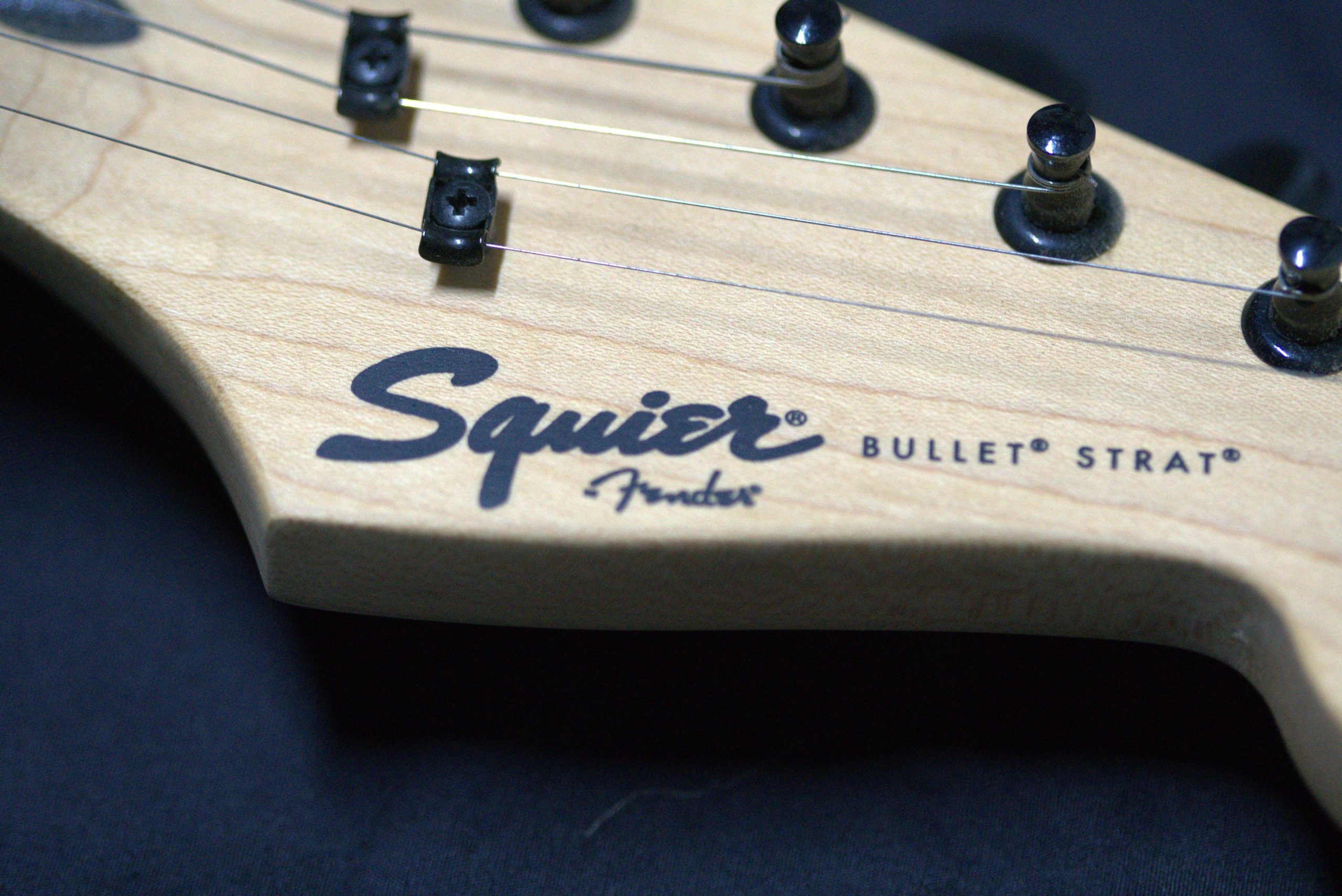
The Bullet series by Squier is the starting point for many guitar players. This is the brands entry level beginner model. The model is based on Fender’s iconic design. Just about any guitar store on the planet will likely have a Squier Bullet series somewhere in their store.
If anything, the Bullet series is the most popular beginner guitar series from any brand you’ll find. Beginner guitarists recognize the shape, note the cheap price tag, and pick it up without a second thought.
However, the cheap price does come with a drop in quality. Bullet guitars do not live up to their Affinity counterparts when it comes to electronics, sound, or durability.
For a beginner, that’s okay, especially if they’re unsure about their new hobby. For someone playing 30 hours a week, that’s bound to become an issue.
The Bullet series includes models such as the Stratocaster, Telecaster, and Mustang. For the price you likely won’t find another guitar with such incredible value and craftsmanship.
The sure variety of colors, body styles, and playability makes this series easy for a novice to select an electric guitar that will fit their style. For example, a Telecaster known for its spanky sound and is well suited for a player who is interested in country music or indie rock. The Mustang uses dual humbuckers that produce a thick-sound that is better for heavy rock music. And the Stratocaster is the most versatile choice that can be used for just about anything from rock to funk.
Affinity Series
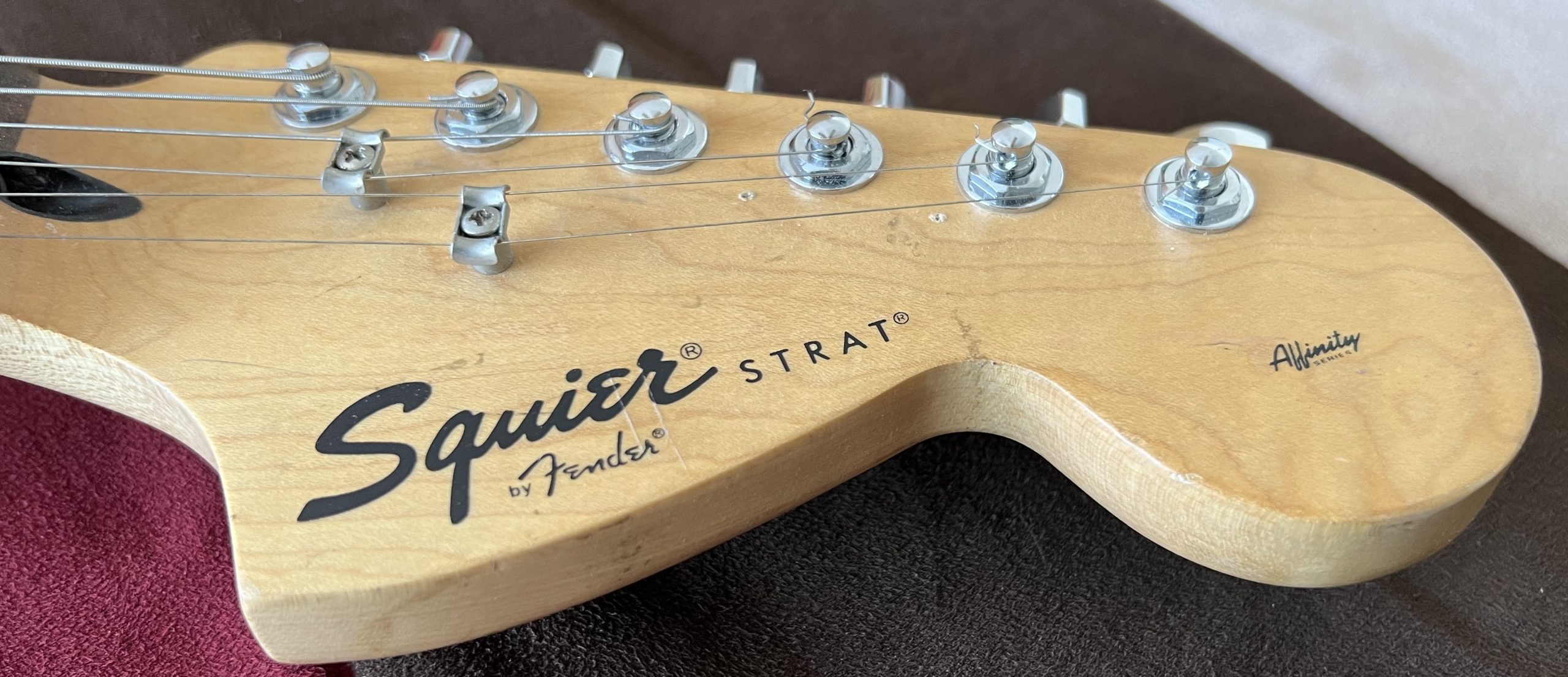
Considered to be the flagship series, the Affinity range is built for beginners but considered a step up from the standard Bullet models. The Affinity range uses better tonewoods, electronics, and hardware.
This series offers a number of body types such as the Stratocaster, Telecaster, Jazzmaster, and the Starcaster. In addition to guitars the Affinity flagship also includes the Jazz Bass and P-Bass models as well.
Without a doubt, the Squier Affinity series has the best reputation for durability. Most Affinity Series players say they keep their guitars for a long time, they stay in good shape, and they have solid tones across all models.
The Affinity series HSS has better sound and control over the intonation, the pickups are generally of higher quality, and the finish is often more appealing than on other series.
However, this improved quality comes at a price, as models from this series tend to be more expensive. Of course, you get what you pay for, but some critics will argue that it isn’t worth it to pay more for a guitar that depreciates in value.
Although, if you’re looking to learn electric guitar and put in the work, you will need a guitar that lasts for a long time. It will be years before you start playing shows, so a quality beginner guitar may suit your needs well.
Classic Vibe Series
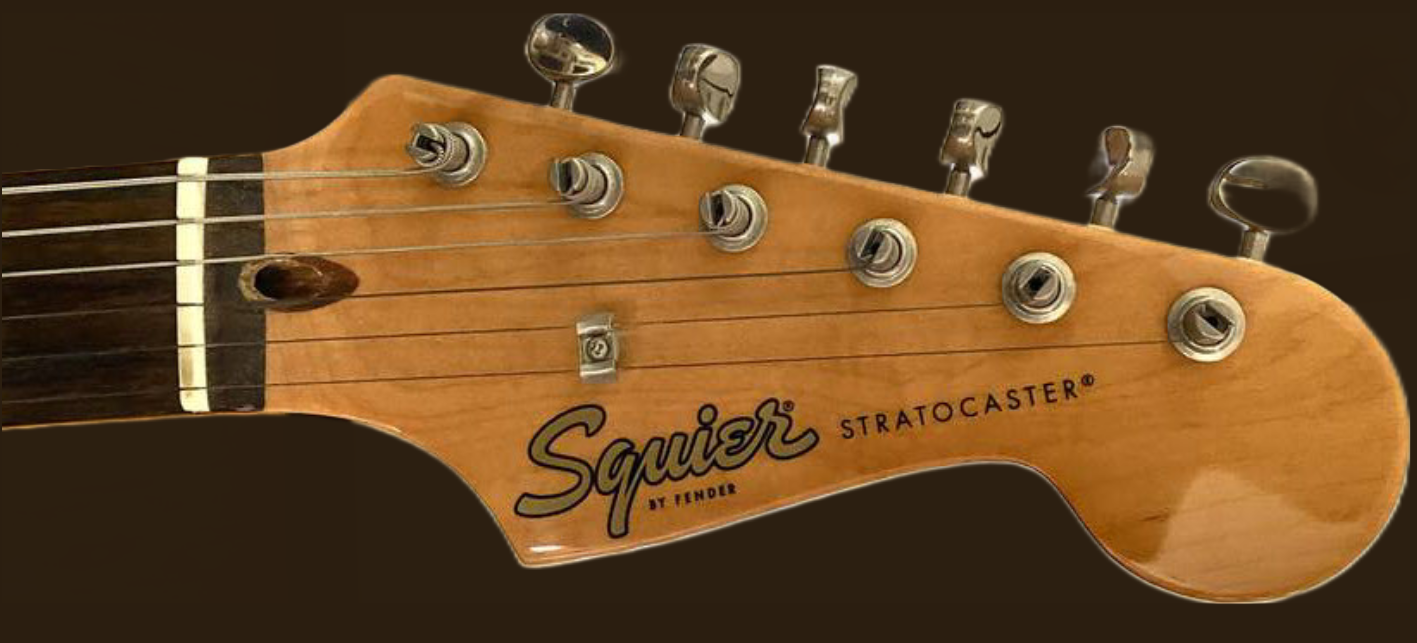
For the player that resonates with vintage guitars might appreciate the Classic Vibe series, which has models based on the 1950’s, 1960’s, and 1970’s. This is a popular option within the catalog and rightly so when comparing these prices to similar options.
Originally launched in 2012, this series might be viewed as a bargain for guitar players. Price isn’t the only upside here. Nostalgia, vintage-voiced pickups, period-correct necks, and authentic sound are all just a few of the upsides to this lineup. The Classic Vibe series offers one of the most diverse collections by the Squier brand. The bulk of the lineup are Strat and Teles but don’t think that there aren’t a number of rarities. Examples range from semi-hollow Starcasters, modded Mustangs, Thinlines, and exotic Esquires. In addition to the Jazz and P-Bass, you can also discover the 1950’s Telecaster basses as well as a Bass VI.
Finally, the Classic Vibe series is likely their least popular series, but that’s mainly because of the price. The Classic Vibe series seeks to replicate the old, classic, prestigious Fender guitars of the ’50s, ’60s, and ’70s as closely as possible.
For this reason, an Affinity or Bullet series guitar may sell for $200 to $300, whereas the same model from the Classic Vibe series will sell starting at $450.
If you see a professional musician playing a Squier, the chances are that it’s from this series. The builds are great, they last for a long time, and they are great for intermediate guitar players!
Key Features:
Body: Alder Body
Neck: C Shape Neck
Fretboard: 25.5 inch scale with 21 frets
Pickups: Vintage Style Pick-ups
Paranormal Series
The Paranormal series by Squier offers a number of cool features that you might not find in other affordable instruments lines. This specific collection includes some oddities and old favorites from past Fender lineups. If you’re looking for a good balance between modern and retro colors, with a look that will stand out, this may be just right up your alley.
Key Features:
Pickups: Alnico pickups
Neck: “C” Shaped neck
Fretboard: 24.75” scale length (similar to Gibson)
Contemporary Series
The Contemporary series was first revealed in 2018 at NAMM as an exciting new offering from the brand. Offering a selection of uber modern guitar and bass models, this offering takes the classic fender design and adds a number of state of the art additions.
These guitars are a good choice for intermediate players, but professionals will likely appreciate their impressive feature set as well. These instruments are especially good for players who are playing heavy genres such as metal. The active humbuckers are good for high gain amplifiers and the “C” shaped neck offers a comfortable feel.
Key Features:
Body styles: Jazzmasters, semi-hollow Starcasters, Stratocasters, Telecasters, and Jazz Basses
Pickups: ceramic active pickups
Neck: slim “C”-shaped
Overall this model may work well for modern genres and all in a comfortable setup.
Artist Series
Like other brands Squier offers a signature model for high-profile customers called the Artist Series. While most of the artist endorsed might use Fender there are still Squier signature instruments that are affordable versions of their guitar hero’s axe.
The Artist Series are created in collaboration with signature musicians. Some of these might be modified versions of current models. They can include custom neck shapes, finishes, hardware, and pickups.
A popular model within this line-up includes the Jim Root Telecaster. This guitar is a signature model from the guitar player of Slipknot. Blackout pickup covers, high-output and C shaped neck are all appreciated for this guitar. For alternative players they might look to the J Mascis Jazzmaster from Dinosaur Jr.
The FSR Series is where the brand creates their limited edition guitars. Like the FSR models by Fender, the Squier FSR are usually based on current models in respective catalogues. Collectors might desire some of the uncommon features such as unique pickup configurations, finishes, and short production runs.
Should You Buy a Squier?
A slight dip in quality, a larger dip in prestige, and likely not made in the US. Okay, these are some of the challenges the brand has had to face, but are they worth it? Well, here’s what you need to ask.
What Is Your Skill Level?
Whether you’re buying a gift for someone else or trying to start a new hobby, a beginner guitarist won’t need too much. Well, there’s a reason we said that the Squier Buller series is the classic beginner brand, and there’s no shame in that title.
A beginner guitarist needs to learn the basics before they worry about intonation or showing off their gear. In that case, electric guitar quality should not be the top priority.
However, a beginner guitarist with a strong will or a musical background may want something that sounds good and lasts for a long time without breaking the bank. In that case, the Affinity series is your best bet.
For intermediate players, we would always recommend the Affinity or Classic Vibe series, especially if you plan to play publicly. Otherwise, go with the classic Fender models.
What Are Your Goals?
If you’re a beginner looking to experiment with the beautiful sounds of a Telecaster, Stratocaster, or any other iconic guitar, then yes, a Squier is probably perfect for you.
However, if you’re looking for a long-term investment, American Telecasters (along with other models) tend to increase in value over time.
Keep in mind, you don’t have to be a beginner to buy a Squier, as their manufacturing is actually top-notch. The branding is the only major difference.
For that reason, it depends on what your goals are. If you’re looking for a collector’s item, then Squiers probably isn’t the right brand for you. However, if you’re looking to make great sounds without breaking the bank, and you don’t mind the “prestige” difference, then there is nothing wrong with buying a Squier.
Many guitarists have been playing for ten years or more and they still continue to buy Squiers. It simply depends on their values.
Who Plays Squier Guitars?
As we said, not many professionals choose to play Squiers, but that doesn’t mean none of them do! While they may come with some modifications, some of the most recognizable names in the industry play Squiers regularly during gigs and recording sessions.
Among the most famous names, we have Canadian jazz legend Jeff Healey, Dave Navarro from Jane’s Addiction (formerly the Red Hot Chili Peppers), and, most notably, Slash from Guns N’ Roses.
Also, two of the most famous bass players in alternative rock history use Squiers, namely Krist Novoselic from Nirvana and Pete Wentz from Fall Out Boy.
Final Thoughts
Chances are, we’ve probably answered most of your questions on Squier guitars. Before we wrap up, let’s answer a couple of common questions surrounding the quality of Squier guitars.
Hear for Yourself
Now that you know a little more about Squier electric guitars, you’re still missing out on a lot of information. The best way to see how well these guitars play is to try them out for yourself!
Overall, these guitars are excellent for beginners and there’s nothing wrong with trying them out for yourself to see how they play.
Stay up to date with our latest guitar news and feel free to contact us with any questions!
Color Codes
- 500 – 3 Color Sunburst
- 501 – Blonde
- 502 – Lake Placid Blue
- 503 – 2-Tone Sunburst
- 504 – Daphne Blue
- 505 – Olympic White
- 506 – Black
- 507 – Vintage Blonde
- 509 – Candy Apple Red
- 512 – Red Sparkle
- 513 – Blue Sparkle
- 517 – Silver Sparkle
- 519 – British Racing Green
- 525 – Metallic Red
- 530 – Cherry Sunburst
- 532 – Brown Sunburst
- 537 – Antique Burst
- 538 – Transparent Red
- 540 – Fiesta Red
- 541 – Vintage White
- 543 – Pewter Gray Metallic
- 544 – Shoreline Gold Metallic
- 546 – Sherwood Green Metallic
- 549 – Sea Foam Green
- 550 – Butterscotch Blonde
- 554 – Dakota Red
- 557 – Surf Green
- 558 – Torino Red
- 560 – Transparent Green
- 562 – Transparent Blue
- 564 – Montego Black Metallic
- 565 – Black Metallic
- 569 – Atlantic Blue Metallic
- 571 – Emerald Green Metallic
- 575 – Wine Red Metallic
- 578 – Aztec Gold
- 580 – Arctic White
- 587 – Cobalt Blue Metallic
- 590 – Baltic Blue
- 591 – Galactic Purple
- 592 – Walnut Satin
- 593 – Purple Metallic
- 594 – Transparent Purple
- 595 – Metallic Blue
References:
https://www.squierwiki.com/Serial-Number-Tracking
https://en.wikipedia.org/wiki/Squier
https://www.fender.com/en-US/squier-electric-guitars